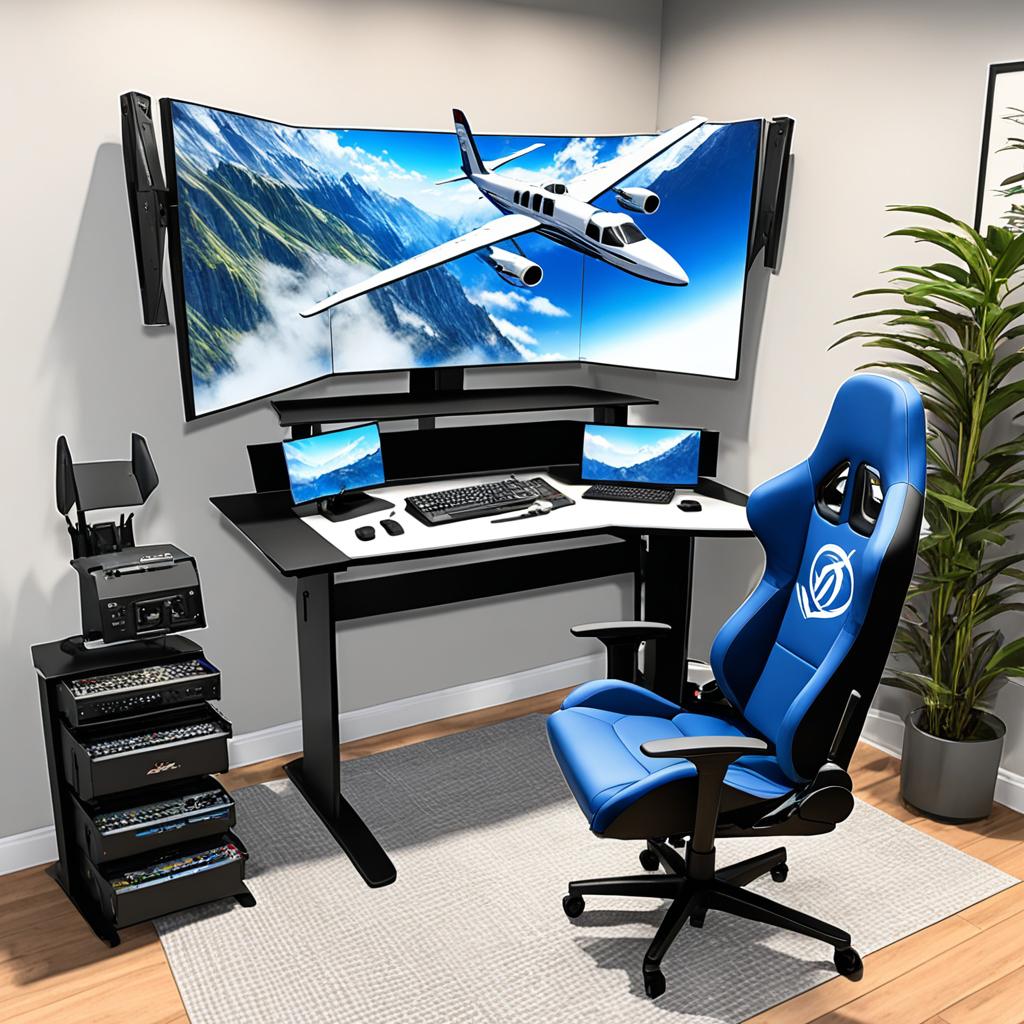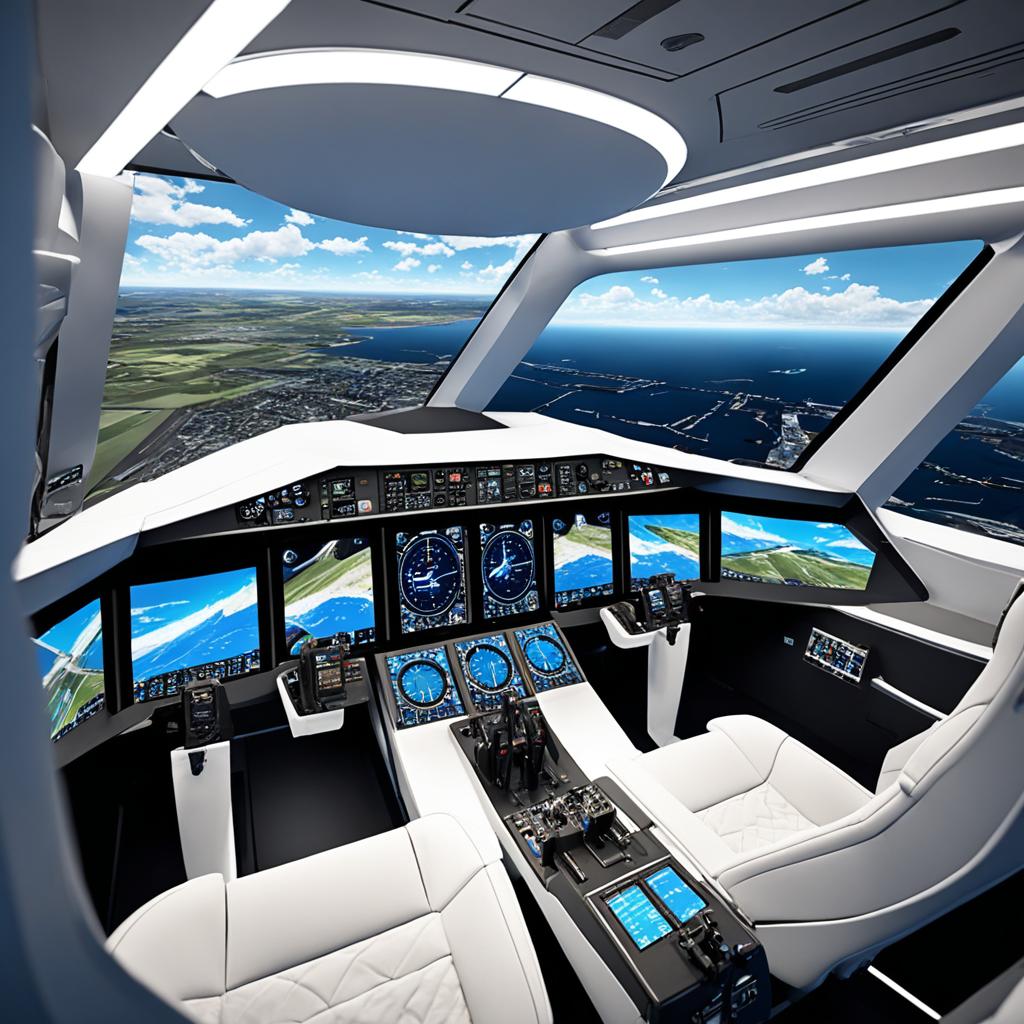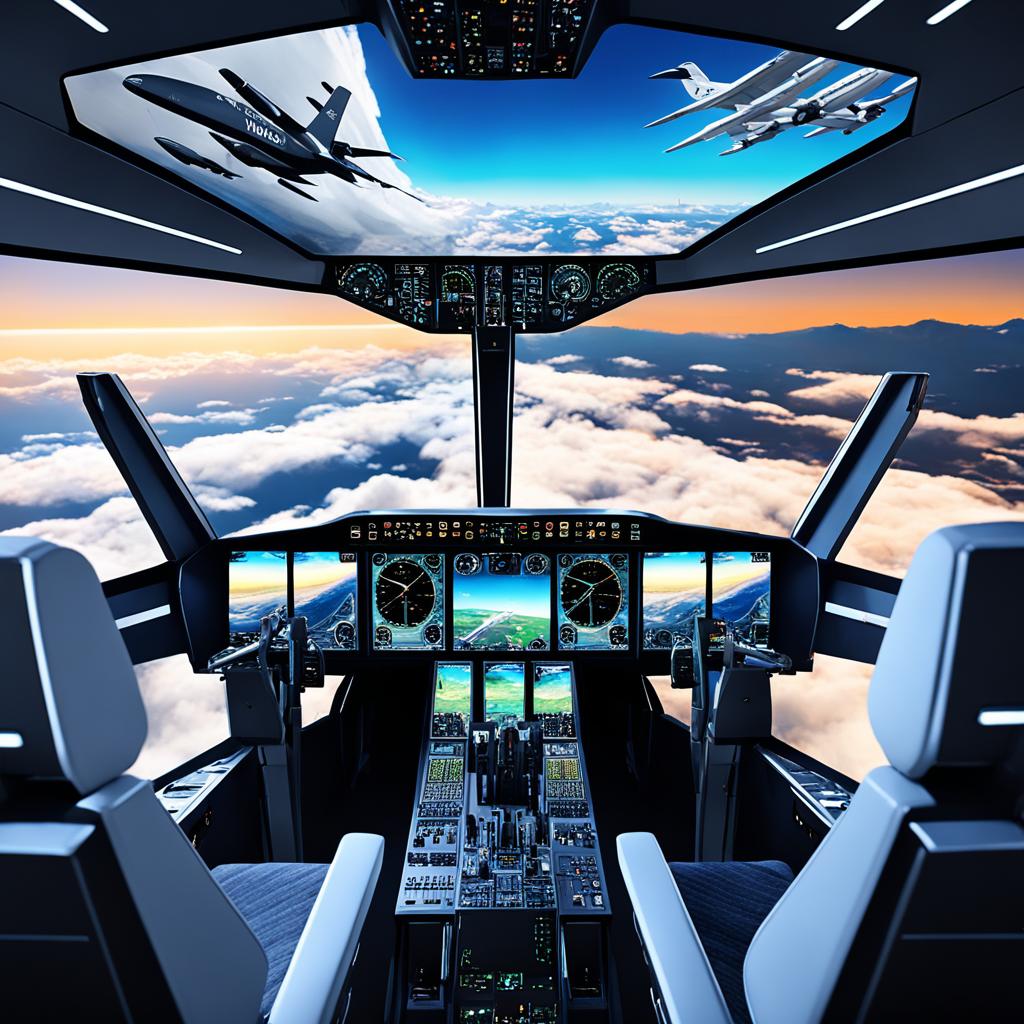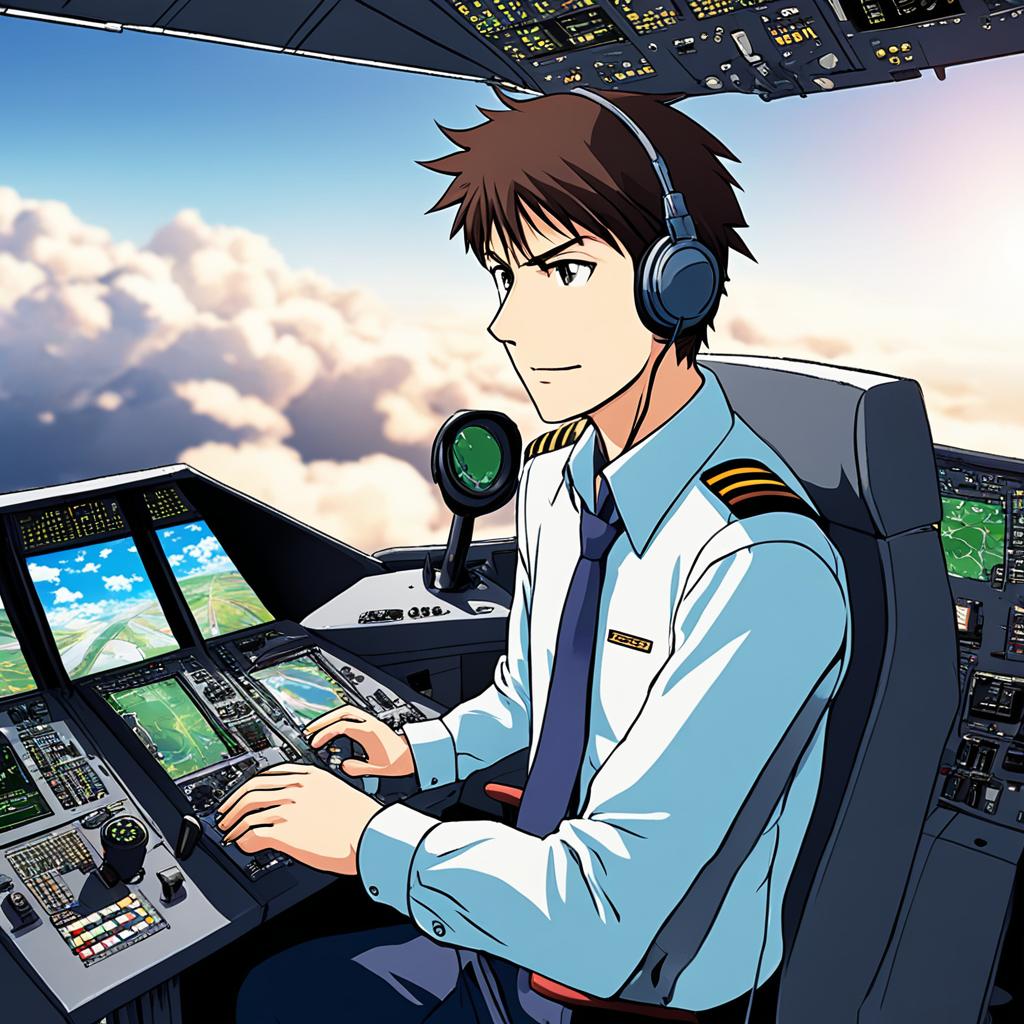Have you ever dreamed of experiencing the thrill of flying a plane from the comfort of your own home? The world of flight simulators allows aviation enthusiasts to do just that. But before you dive headfirst into building your own flight simulator setup, there’s an important question that needs to be answered: how much does it cost to install a flight simulator?
Installing a flight simulator involves several components that contribute to the overall cost. From the PC and software to monitors, controls, and even the simulator seat, each element plays a part in determining the price. But what exactly is the price range for a home flight simulator? Is it within reach of your budget? It’s time to dig deeper and find out.
Necessary Products for Building a Flight Simulator
To build a flight simulator, you will need several essential components and equipment. These are essential for creating a realistic and immersive flight experience. Here are the necessary products you should consider:
- PC: A powerful computer is the backbone of your flight simulator setup. It should have a fast processor, ample RAM, and a dedicated graphics card to handle the demanding graphics and calculations.
- Flight Simulator Software: An important element of your setup is the flight simulator software. There are various options available in the market, such as X-Plane and Microsoft Flight Simulator.
- Monitors: Multiple monitors provide a panoramic view of your simulated flight. You can choose between a single large screen or a multi-monitor setup to enhance your visual experience.
- Avionic Controls: These include a yoke or joystick, rudder pedals, and throttle quadrant. These controls mimic the ones found in real aircraft and allow you to have a hands-on experience during your flight simulation.
- Simulator Seat or Frame System: To complete your flight simulator setup, you will need a comfortable and adjustable simulator seat or frame system. This ensures stability and proper ergonomics during your simulated flights.
These components form the foundation of your flight simulator and contribute to the overall cost of building one. It’s essential to choose products that align with your budget, preferences, and compatibility with the flight simulator software you plan to use.
Entry-Level Flight Simulator Cost

An entry-level flight simulator is an excellent choice for those who are looking for an affordable option to begin their flight training or enhance their aviation skills. These setups are designed to provide a realistic flight experience while being budget-friendly. If you are considering building an entry-level flight simulator, it’s important to understand the cost involved.
The cost of an entry-level flight simulator setup can range from $2,500 to $3,000. This includes all the essential components needed to create a functional and immersive flight experience:
- PC: A reliable computer system is the heart of any flight simulator setup. You will need a powerful PC capable of running the flight simulator software smoothly.
- Monitors: Multiple monitors are essential to create a panoramic display of the aircraft’s cockpit. This allows for better visibility and immersion.
- Avionic Controls: The yoke or joystick, rudder pedals, and throttle quadrant are essential controls for flying the simulated aircraft.
- Software: The flight simulator software is the backbone of the setup. It provides the virtual environment and aircraft models for you to fly.
With these components, an entry-level flight simulator setup can replicate the experience of flying small single-engine aircraft. It’s ideal for flight training, currency practice, or simply enjoying the thrill of flying from the comfort of your own home.
Comparison of Entry-Level Flight Simulator Costs
| Component | Average Cost |
|---|---|
| PC | $800 – $1,200 |
| Monitors | $300 – $500 |
| Avionic Controls | $300 – $500 |
| Software | $100 – $200 |
| Total | $2,500 – $3,000 |
These cost estimates are based on average market prices and can vary depending on the brand, quality, and specific features of the components you choose. It’s essential to do thorough research and compare prices to find the best deals within your budget.
An entry-level flight simulator setup provides an affordable way to get started in the world of flight simulation. Whether you are a beginner pilot or an aviation enthusiast, this setup offers a cost-effective solution to experience the thrill of flying without breaking the bank.
Mid-Range Flight Simulator Cost

If you’re looking to elevate your flight simulator experience with advanced features and enhanced functionality, a mid-range setup is the perfect choice. The cost of a mid-range flight simulator can range from approximately $7,075 or more, depending on the specific components and accessories you choose. This price range includes essential items such as a high-performance PC, multiple monitors, avionic controls like a yoke or joystick, rudder pedals, throttle, and flight simulator software.
One key feature of mid-range setups is the inclusion of advanced systems like the G1000 Suite, which offers enhanced flight planning and navigation capabilities. These systems deliver a more realistic experience and are especially beneficial if you’re looking to simulate modern aircraft or complex flight scenarios.
Components and Price Breakdown for a Mid-Range Flight Simulator Setup
| Component | Price Range |
|---|---|
| High-performance PC | $1,500 – $3,000 |
| Monitors (2 – 3) | $300 – $800 |
| Avionic Controls (yoke or joystick, rudder pedals, throttle) | $500 – $1,200 |
| Flight Simulator Software | $100 – $300 |
| Total | $7,075 or more |
Investing in a mid-range flight simulator setup allows you to enjoy a more immersive and true-to-life aviation experience. It strikes a balance between affordability and advanced features, making it suitable for flight enthusiasts and aspiring pilots who want a realistic training environment. However, it’s essential to research and compare different components and prices to ensure you choose the options that best fit your budget and simulation goals.
Advanced Flight Simulator Cost

For those who want the most immersive and realistic flight simulator experience, an advanced setup is the way to go. The cost of an advanced flight simulator can range from $17,495 or more. These setups often include a complete cockpit package with all the components found in an actual aircraft, such as a full instrument panel, control columns, rudder pedals, throttle quadrant, and more. While these setups are more expensive, they offer a high level of realism and are often used by professional pilots for training and practice.
If you’re serious about aviation and want to simulate a professional-grade experience, investing in an advanced flight simulator is worth considering. These high-end simulators provide an unparalleled level of realism, allowing you to train and practice in a realistic cockpit environment.
| Component | Price Range |
|---|---|
| PC | $2,000 – $5,000 |
| Monitors | $500 – $1,500 |
| Avionic controls | $2,000 – $5,000 |
| Simulator seat | $3,000 – $10,000 |
These are just rough estimates, and the actual cost can vary depending on the brand, quality, and specific features of each component. It’s important to thoroughly research and compare different options before making a purchase.
Investing in an advanced flight simulator may seem expensive, but it can provide immense value for professional pilots, flight schools, and aviation enthusiasts who want to experience a truly realistic flying experience. With the advancement of technology, these simulators continue to evolve, offering even more realistic and detailed simulations with each new iteration.
By investing in an advanced flight simulator, you can enhance your flight training, improve your skills, and immerse yourself in a lifelike aviation experience without leaving the ground. Whether you’re practicing instrument approaches, honing your navigation skills, or perfecting your flight maneuvers, an advanced flight simulator can provide a safe and cost-effective way to enhance your flying abilities.
When considering the cost of an advanced flight simulator, it’s important to weigh the benefits and long-term value it brings. While the upfront cost may be higher, the ability to practice and train in a realistic environment can save you money on actual flight hours and enhance your overall proficiency as a pilot.
In the next section, we will explore the factors you should consider when building a flight simulator to ensure you make the right choices and stay within your budget.
Factors to Consider When Building a Flight Simulator
When building a flight simulator, there are several factors to consider that can affect the overall cost. Taking into account these considerations will ensure that you make informed decisions and create a setup that meets your needs and budget. Here are some key factors to think about:
- Purpose of your sim: Determine whether you’re building the flight simulator for recreational purposes or as a tool to supplement real-life pilot training. This will help you prioritize features and functionalities.
- Type of aircraft: Consider the specific aircraft you plan to simulate. Different aircraft types require different controls and systems, which can impact the cost and complexity of your simulator setup.
- Portability: Evaluate whether you need your flight simulator to be portable or if it will be permanently set up in a dedicated space. Portability can affect the choice of components and their cost.
- Your budget: Determine the budget you’re willing to allocate for building your flight simulator. This will help you prioritize your expenses and make choices that align with your financial resources.
By carefully considering these factors, you’ll be able to plan and build a flight simulator that suits your requirements and stays within your budget.
Choosing the Right Flight Simulator Software
When it comes to flight simulator software, two options stand out from the crowd: X-Plane and Microsoft Flight Simulator (MSFS). These programs offer unique features and cater to different preferences, making it crucial to consider your specific needs before making a decision.
X-Plane is renowned for its exceptional realism and extensive customization options. It provides a highly accurate flight model and a wide range of aircraft to choose from, allowing you to simulate various scenarios and hone your flying skills. Whether you’re a casual enthusiast or a seasoned pilot, X-Plane offers a robust platform for both entertainment and training purposes.
On the other hand, Microsoft Flight Simulator boasts stunning graphics and a massive community of users. The program utilizes advanced technology to create incredibly realistic and visually appealing environments, making each flight an immersive experience. With regular updates and a thriving online community, MSFS offers a dynamic and social aspect to flight simulation.
Ultimately, the choice between X-Plane and Microsoft Flight Simulator depends on your personal preference and the specific features you prioritize. Consider factors such as realism, customization options, graphics, aircraft selection, and community engagement. Take the time to research and compare both software programs to ensure that you invest in the best flight simulator software for your needs.


